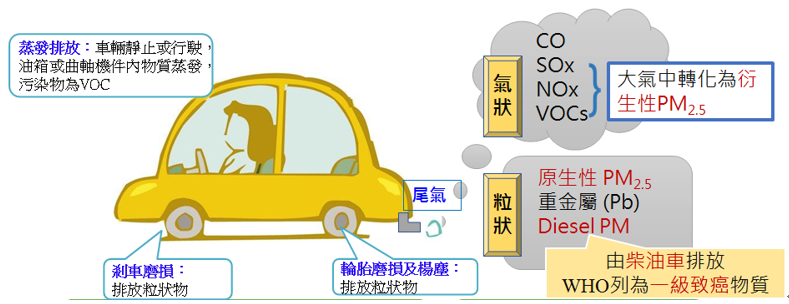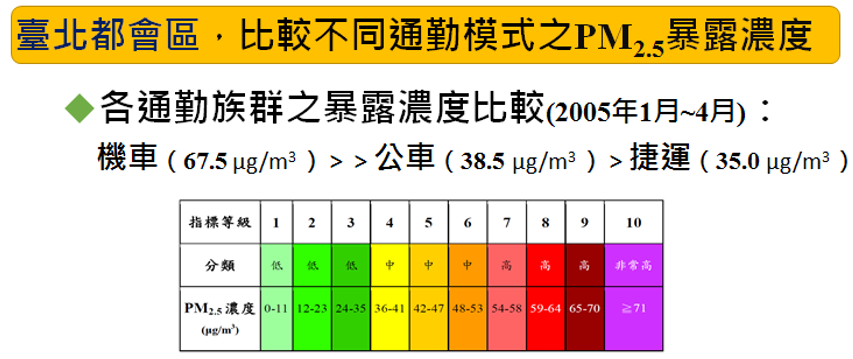Risk and Causes of Air Pollution Exposure in Traffic Environment
- Date:2019-03-06
- Update:2019-03-06
- Department:IOT
Project Overview:
Recently, the public is increasingly concerned with the air pollution. The main cause of metropolitan traffic pollution is from vehicle emissions (refer to Figure 1). The management thinking of transportation units is mostly in pursuit of operational safety and transportation efficiency, and pays less attention to the problem of concentrated air pollution emitted by traffic sources that affect public health. The Environmental Protection Administration has estimated the source of PM2.5 concentration in the country, with domestic mobile pollution source accounted for 30%~37%. In order to assist the Ministry of Transportation and Communications to control traffic pollution, as well as develop an air pollution prevention strategy, this project collects research of domestic and foreign traffic sources Particulate Matter (PM2.5) exposure field surveys to understand the risks and causes of air pollution exposure in traffic environments, and proposes recommendations for management strategies for reducing traffic pollution ..
Research Outcomes:
(1)Completed a traffic pollution literature analysis
- Research on the exposure of Particulate Matter (PM2.5) in traffic environment:
- The field survey of Taipei Metropolitan Area on commuters (Liu et al., 2015; Dai-Hua Tsai et al., 2008; Shih-Chun Candice Lung, 2005) found that in different commuter modes of transportation, the exposure of PM2.5 for motorcyclists is much higher than the commuters riding public transportation vehicles of bus and MRT.
- PM exposure of the bus waiting groups at bus stops in Rome, Italy (Maurizio et al., 2017), the field survey found that a very large amount of ultrafine particle fraction (PM0.1) was emitted instantaneously from the bus arrivingn at and leaving from the bus stops.
- Traffic Pollution Reduction and Control Strategy Trends: The international focus has been on private control strategies including license plate control, city access fees and vehicle pollution grading. Recently, we will also limit the use of high pollution vehicles by delineating air quality maintenance zones and raising the environmental standards of old and used vehicles through amending the law.
(2)Recommended air pollution prevention strategies and guidelines to the transportation sector
Recommendations for reducing overall traffic pollution emissions strategies: including "Proposal on a phase-out deadline for diesel bus subsidies", "Proposal onf the feasibility program for tightening the vehicle possession conditions, slowing down the growth rate of vehicles", "Proposal on levying additional annual air pollution by age and type of vehicles", as well as "Augment Energy Efficiency Standards for Large Trucks".
- Recommendations for reducing the traffic micro-environment exposure measures: “Vehicle classification labeling and prohibiting high pollution vehicles from entering air quality zones”, “Proposal to change the position of bus exhaust pipes (upward)”, “Promote motorcycles to Turn off their Engines while Idling while waiting at Red Light", "Plant street trees with higher adsorption of PM2.5".
Promotion of Outcomes and Benefits :
(1)We briefed the Minister and heads of agencies a an intrnal conference of the Ministry of Transportation and Communications in July 2017, on the focus of phased literature review, for them to understand the importance of PM2.5 exposure from traffic environment pollution sources and conduct planning on pollution reduction strategies.
(2)We developed 5 major strategies, 14 measures and 37 recommendations of promotional works in the “Recommendations for Reducing Traffic Pollution Source Management Measures” in November 2017, and briefed the Minister and heads of agencies under the ministry. Most of the recommendations were approved by the Minister and the departments and subordinated agencies were instructed to turn the recommendations into practical actions.
(3)We composed the "Comparison of Commuters Exposed to PM2.5 Concentration in Taipei Area" popular science short essay in April 2018, to promote the knowledge that high PM2.5 exposure is harmful to the health of motorcyclists through the Good Life Connector Social Networking Community (Facebook) of the Ministry of Transportation and Communications, to change the behavior of vehicle selection for the motorcyclists.










